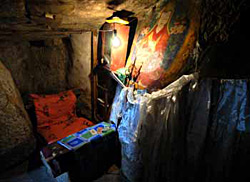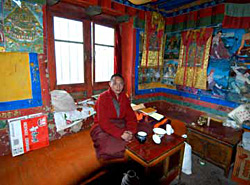by José Ignacio Cabezón and THL.
History
RakhadrakRa kha brag is renowned in GelukDge lugs history chiefly for two things. It was the place where TsongkhapaTsong kha pa composed his great classic, The Essence of Eloquence that Distinguishes Between the Provisional and Definitive Meaning of the Scriptures (Drangngé Lekshé NyingpoDrang nges legs bshad snying po), and it is one of the places where TsongkhapaTsong kha pa received the delegation from the emperor of China, the so-called “bearers of the golden letter” (seryikpagser yig pa) who had been sent with an invitation requesting TsongkhapaTsong kha pa’s presence at the Chinese court.

The inside of TsongkhapaTsong kha pa’s meditation cave (druppuksgrub phug).
One contemporary Tibetan historian1 informs us that the site was founded as a formal monastic institution with twelve fully ordained monks by Drupkhang Gelek GyatsoSgrub khang dge legs rgya mtsho (1641-1713) in the eighteenth century. Another contemporary historian of SeraSe ra identifies the founder of RakhadrakRa kha brag as Rakhadrak Azhu SönamRa kha brag a zhu bsod nams (b. seventeenth century). This latter account accords with the oral report of one of the monks presently living at the site, who gives the name of this figure Akha Sönam ZangpoA kha bsod nams bzang po (b. seventeenth century),2 and who adds that he was a student of the Fifth Dalai Lama (Dalai Lama Kutreng NgapaDa lai bla ma sku phreng lnga pa). This informant also states that the upper temple complex was founded as a formal monastery with the financial sponsorship of the mother of the Fifth Dalai Lama (Dalai Lama Kutreng NgapaDa lai bla ma sku phreng lnga pa), who apparently was the hermitage’s main sponsor throughout most of her adult life. The two accounts may not be mutually contradictory. It may be that the upper temple compound, housing a handful of monks, was initially built with the financial sponsorship of members of the Fifth Dalai Lama’s court in the seventeenth century. The institution may have then come under the control of the charismatic Drupkhang Gelek GyatsoSgrub khang dge legs rgya mtsho several decades later, and perhaps it was at this time that it began to flourish as a formal monastery.
Apart from these few facts, we can say little about the history of RakhadrakRa kha brag at this point in our research. Like all of hermitages of Sera (Seré ritröse ra’i ri khrod), RakhadrakRa kha brag was abandoned and deteriorated following the events of 1959, and especially following the Cultural Revolution. It was taken over by SeraSe ra in the 1980s, and the main sites – the lower cave complex and a portion of the upper temple compound – have been minimally restored. Today it is staffed by two elder SeraSe ra monks, who keep the site open for pilgrims. A few rooms are made available to SeraSe ra monks who wish to do retreat at the hermitage during inter-terms. There is no longer any active ritual life at the hermitage.
 A SeraSe ra monk is engaged in retreat in the ante-room outside TsongkhapaTsong kha pa’s meditation cave at RakhadrakRa kha brag. |
Hermitages Home
Table of Contents
- Location and Layout
- History
- Glossary
- Notes
- Specify View:
- Specify Format:
 |  |  |